Somehow a more innocent time, and with Vera Lynn’s passing at 103 it’s really passed definitively into History.
A long-ago world
Somehow a more innocent time, and with Vera Lynn’s passing at 103 it’s really passed definitively into History.
This doesn’t need an answer so much as it focuses one’s attention on what the Mind is doing, is working upon in the background of consciousness. Thus, it makes a good Question for each of us to consider and perhaps respond to in the familiar idiosyncratic and free-associative fashion. Consciousness is always busy processing sensory input, appreciating the seen and heard and felt and tasted. But what’s going on beneath? Are the three wonderments described below the SAME in some sense? Are they all entangled in the perennial Question of how complexity and dynamical systems work, perhaps? We are clearly off the fairway, into the weeds, the rough, the unknown. Where I love to be wandering, if the truth be told.
So here’s a sketch of my own current state, made up of Questions emerging from the stimuli that have drifted across the bow in the last few days. We can begin with the observation of many many thousands of tiny orange ants in the soil I’ve been sifting from the sod that was stripped from the garden space. What, we wonder, are they doing? Where do they fit in? Is there some mutualism with the co-occurring worms, and/or with unseen other somethings? How could we learn more? [partial answer: a soon-to-arrive Field Guide to the Ants of New England].
A second element is this video of “7 levels of jazz harmony”:
And a third element in temporal conjunction with the two above is the just-published and just-arrived (via Kindle and Audible) Entangled Life: How Fungi Make Our Worlds, Change Our Minds & Shape Our Futures by Merlin Sheldrake [who is, remarkably and synchronistically enough, the son of Rupert Sheldrake, of Morphic Resonance fame], which I started to read this morning.
Here are the passages I highlighted as I read the Introduction, to illustrate my habitual process of collecting bits of aide mémoire, breadcrumbs along the pathway:
Introduction: What Is It Like to Be a Fungus?
Page 10
…[mycelia] weave themselves through the gaps between plant cells in an intimate brocade and help to defend plants against disease .Page 11
Mushrooms are a fungus’s way to entreat the more-than-fungal world, from wind to squirrel, to assist with the dispersal of spores, or to prevent it from interfering with this process.Page 12
Mycelium describes the most common of fungal habits, better thought of not as a thing but as a process: an exploratory, irregular tendency.Page 14
Unsustainable agricultural practices reduce the ability of plants to form relationships with the beneficial fungi on which they depend. The widespread use of antifungal chemicals has led to an unprecedented rise in new fungal superbugs that threaten both human and plant health. As humans disperse disease-causing fungi , we create new opportunities for their evolution.Page 18
…many fungi can live within the roots of a single plant, and many plants can connect with a single fungal network. In this way a variety of substances , from nutrients to signaling compounds, can pass between plants via fungal connections.Page 20
Tricked out of our expectations, we fall back on our senses. What’s astonishing is the gulf between what we expect to find and what we find when we actually look.Page 23
Many scientific concepts—from time to chemical bonds to genes to species—lack stable definitions but remain helpful categories to think with.Page 25
There was something embarrassing about admitting that the tangle of our unfounded conjectures, fantasies, and metaphors might have helped shape our research. Regardless, imagination forms part of the everyday business of inquiring.Page 27
…wondered what it was like to be a fungus. I found myself underground, surrounded by growing tips surging across one another. Schools of globular animals grazing—plant roots and their hustle—the Wild West of the soil—all those bandits, brigands, loners, crapshooters. The soil was a horizonless external gut—digestion and salvage everywhere—flocks of bacteria surfing on waves of electrical charge—chemical weather systems—subterranean highways—slimy infective embrace—seething intimate contact on all sides.
I’ll also point to an article in this week’s New Yorker, The Secret Lives of Fungi by Hua Hsu, which references Sheldrake and also Anna Haupt Tsing’s The Mushroom at the End of the World: On the Possibility of Life in Capitalist Ruins, which I read with great pleasure last summer.
You just never know what the day will bring, and how thing will lead to thing.
I started with a chapter from Italo Calvino’s If on a winter’s night a traveler, the second part of the first one, which finds the reader in a provincial town railroad station:
The novel begins in a railway station, a locomotive huffs, steam from a piston covers the opening of the chapter, a cloud of smoke hides part of the first paragraph. In the odor of the station there is a passing whiff of station café odor. There is someone looking through the befogged glass, he opens the glass door of the bar, everything is misty, inside, too, as if seen by nearsighted eyes, or eyes irritated by coal dust. The pages of the book are clouded like the windows of an old train, the cloud of smoke rests on the sentences…
Not in Kansas anymore, hein?
The word that springs to mind is “immersive” but whether anybody else has ever been so sprung upon I know not. At the end of Calvino chapter 1 I begin to read chapter 2:
You have now read about thirty pages and you’re becoming caught up in the story. At a certain point you remark: “This sentence somehow seems familiar. In fact, this whole passage reads like something I’ve read before.” Of course: there are themes that recur, the text is interwoven with these reprises, which serve to express the fluctuation of time. You are the sort of reader who is sensitive to such refinements; you are quick to catch the author’s intentions and nothing escapes you….
Hm. And so I put down Calvino and picked up where I left off yesterday in Becker’s Many Subtle Channels: In Praise of Potential Literature (Calvino having been a Oulipian, this seemed perfectly sensible) and the feel of the reading seems the same, some amalgam of fictional narrative and factual discourse where it’s perhaps difficult or possibly pointless to say what is real and what imaginary…
And then a look at the RSS feed’s latest brought me this:
You know what? Just google him now. Pause this video.
Now, I’ve never gotten William Eggleston as a photographer, and the why of that is surely worth exploring. I accept that he’s widely regarded as one of the modern masters, and I know that John Sarkowski, whom I revere, recognized him with an early solo show at MoMA in 1976 (the first of color photography): William Eggleston’s Guide is Szarkowski’s catalog for the show, and see also a pdf of Szarkowski’s Introduction. Here’s a section of the Amazon blurb for the book:
The book and show unabashedly forced the art world to deal with color photography, a medium scarcely taken seriously at the time, and with the vernacular content of a body of photographs that could have been but definitely weren’t some average American’s Instamatic pictures from the family album. These photographs heralded a new mastery of the use of color as an integral element of photographic composition.
My own photographic aesthetic is deeply dipped in the world of black-and-white photography, mostly before 1976, though I’ve taken to color myself ever since my transition to digital imaging more than 10 years ago. Eggleston’s color and composition just rub me the wrong way, and generally my reaction to his images has been “so what?”, but a couple of years ago I saw a selection at full size at Pier 24 in San Francisco, and began to realize that my judgements have been ill-placed. So I continue to try to reeducate myself away from long-running prejudices. But I’m still leery of Eggleston.
So back to the video, and its “new genre” possibilities, and how all of that might fit with Calvino and with OuPhoPo (the Workshop in Experimental Photography). The text of the video references a New York Times profile of Eggleston, in which he is revealed to be an over-the-top alcoholic.
…WE LEAVE THE OFFICES of the Eggleston Trust and go to his apartment. The first thing one sees upon entering is a bright red plastic sign with a yellow border, printed with capitalized white sans-serif text. It warns, “THE OCCUPANT OF THIS APARTMENT WAS RECENTLY HOSPITALIZED FOR COMPLICATIONS DUE TO ALCOHOL. HE IS ON A MEDICALLY PRESCRIBED DAILY PORTION OF ALCOHOL. IF YOU BRING ADDITIONAL ALCOHOL INTO THIS APARTMENT YOU ARE PLACING HIM IN MORTAL DANGER. YOUR ENTRY AND EXIT INTO THIS APARTMENT IS BEING RECORDED. WE WILL PROSECUTE SHOULD THIS NOTICE BE IGNORED. THE EGGLESTON FAMILY.” It is a devastating thing to see. Heartbreaking. I was also an alcoholic for decades, the kind who had shakes and saw spiders. I’m not even through the hallway and my mind is racing from “I want that sign” to “What kind of doctor prescribes alcohol for an alcoholic? Where was he when I was drinking?”
The text of the song in the video:
What if the thing that helps you live
Is also the thing that will get you killed
It’s the damndest thing
I don’t think I’d ever heard of Beauty Pill, but here are two more remarkable videos:
and
Dog With Rabbit in Mouth Unharmed
And that was all before 10 AM.
Nicolas Slonimsky (1894-1995) is famous for several things, the most immediately relevant here being his Lexicon of Musical Invective: Critical Assaults on Composers Since Beethoven’s Time. The Amazon blurb:
A snakeful of critical venom aimed at the composers and the classics of nineteenth- and twentieth-century music. Who wrote advanced cat music? What commonplace theme is very much like Yankee Doodle? Which composer is a scoundrel and a giftless bastard? What opera would His Satanic Majesty turn out? Whose name suggests fierce whiskers stained with vodka? And finally, what third movement begins with a dog howling at midnight, then imitates the regurgitations of the less-refined or lower-middle-class type of water-closet cistern, and ends with the cello reproducing the screech of an ungreased wheelbarrow? For the answers to these and other questions, readers need only consult the “Invecticon” at the back of this inspired book and then turn to the full passage, in all its vituperation.
The Invecticon lists 30+ pages of calumnies and disparagements:
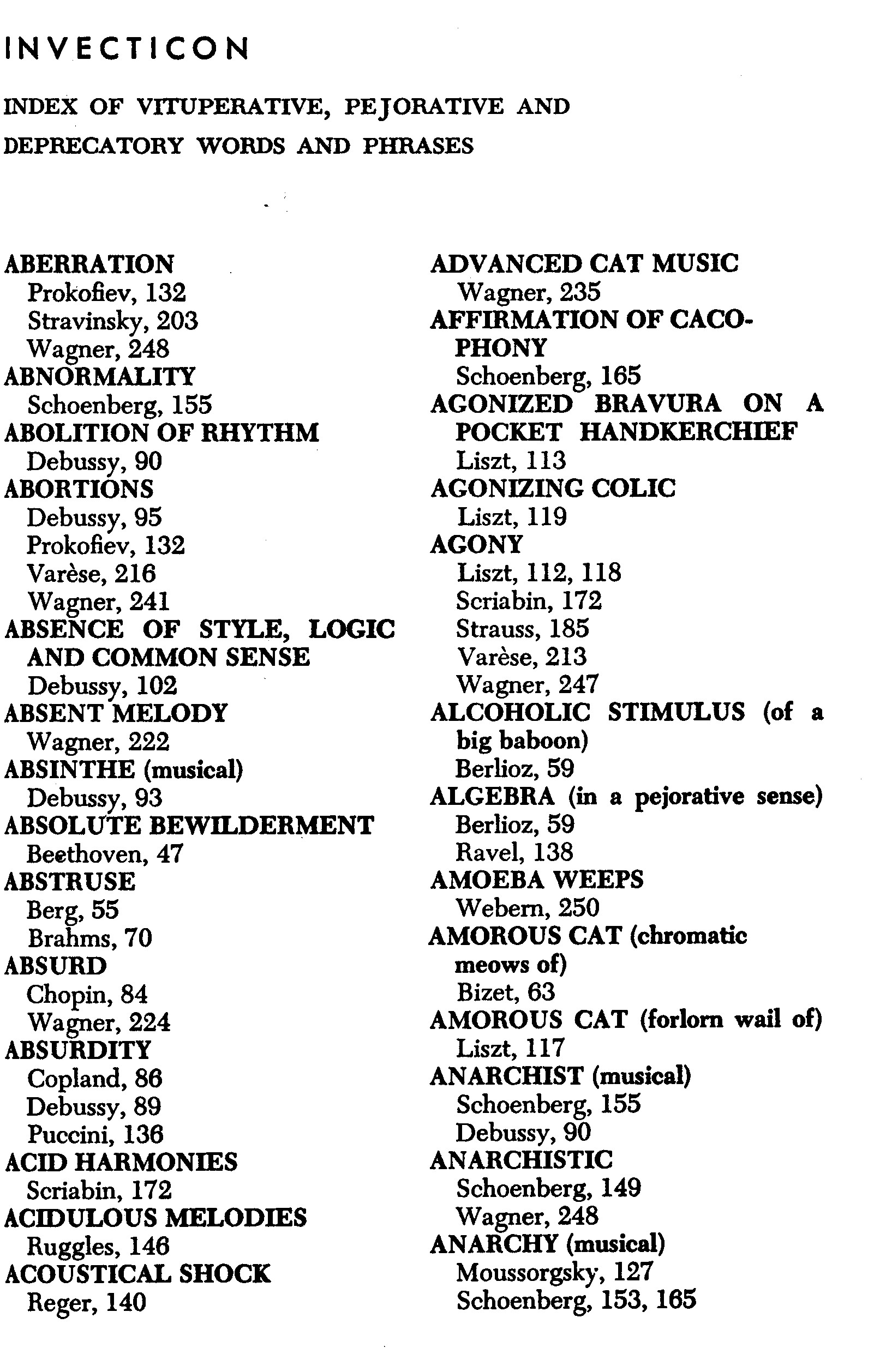

and examples of Critical Response: Stravinsky, Webern and Varèse
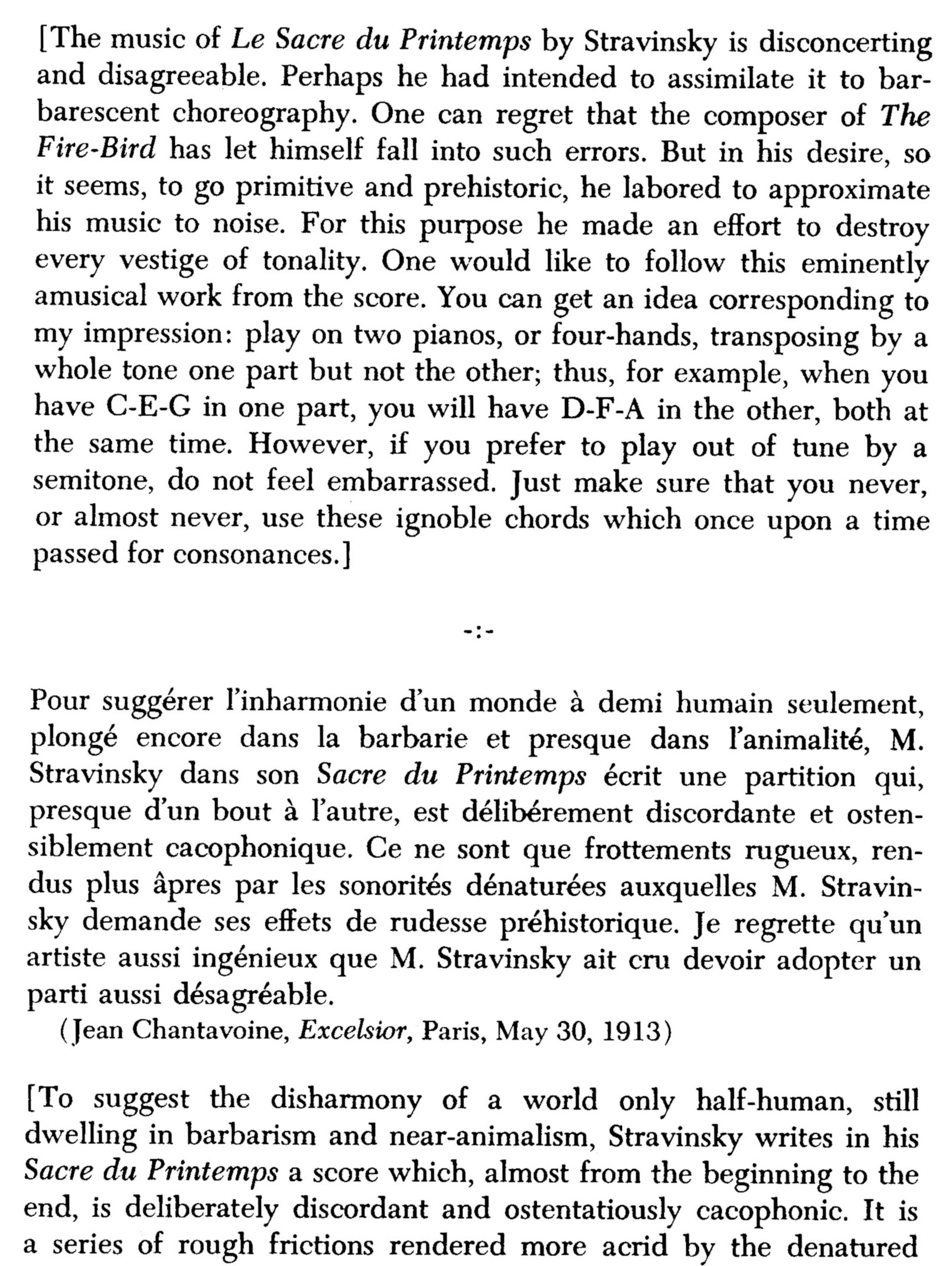
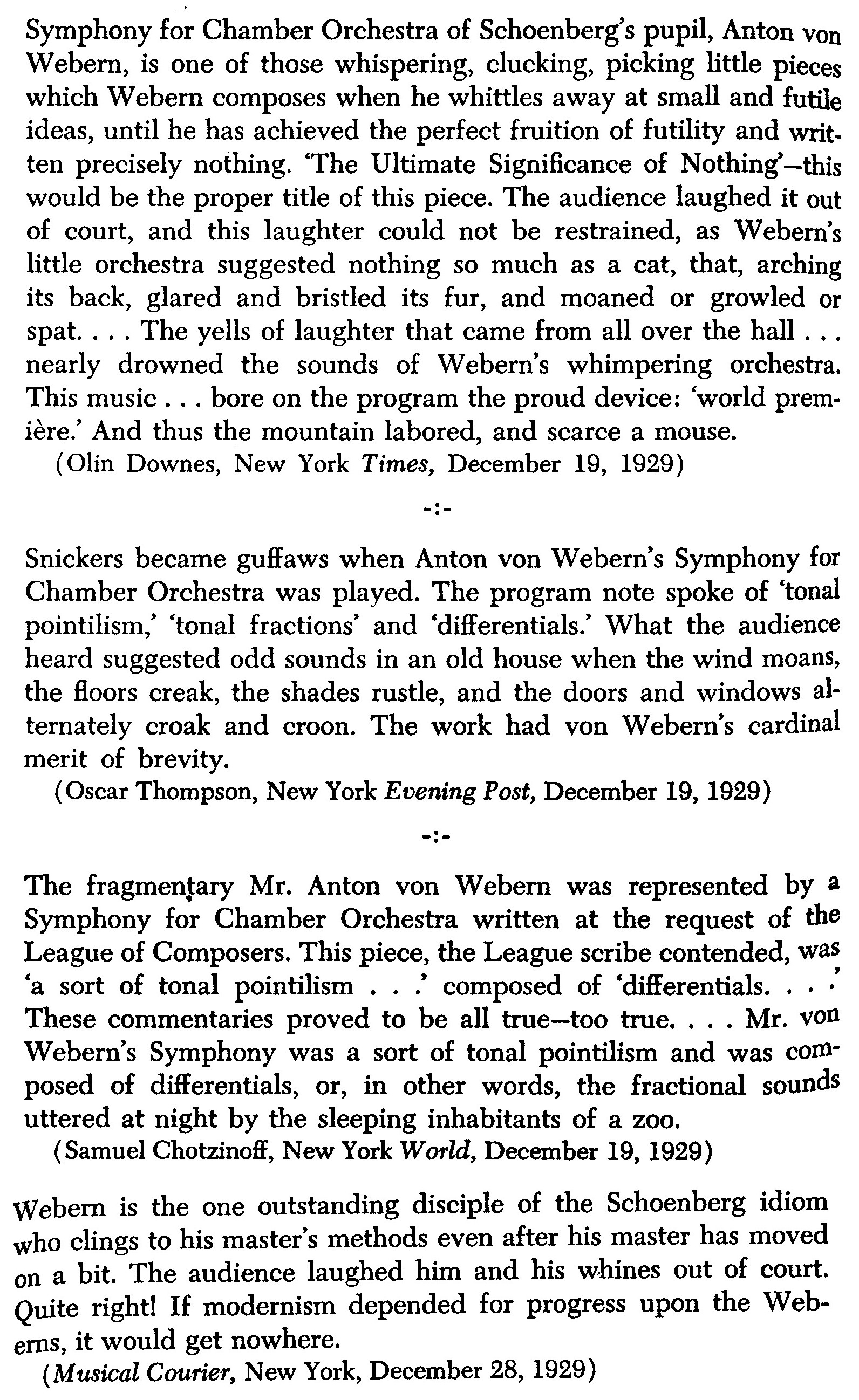
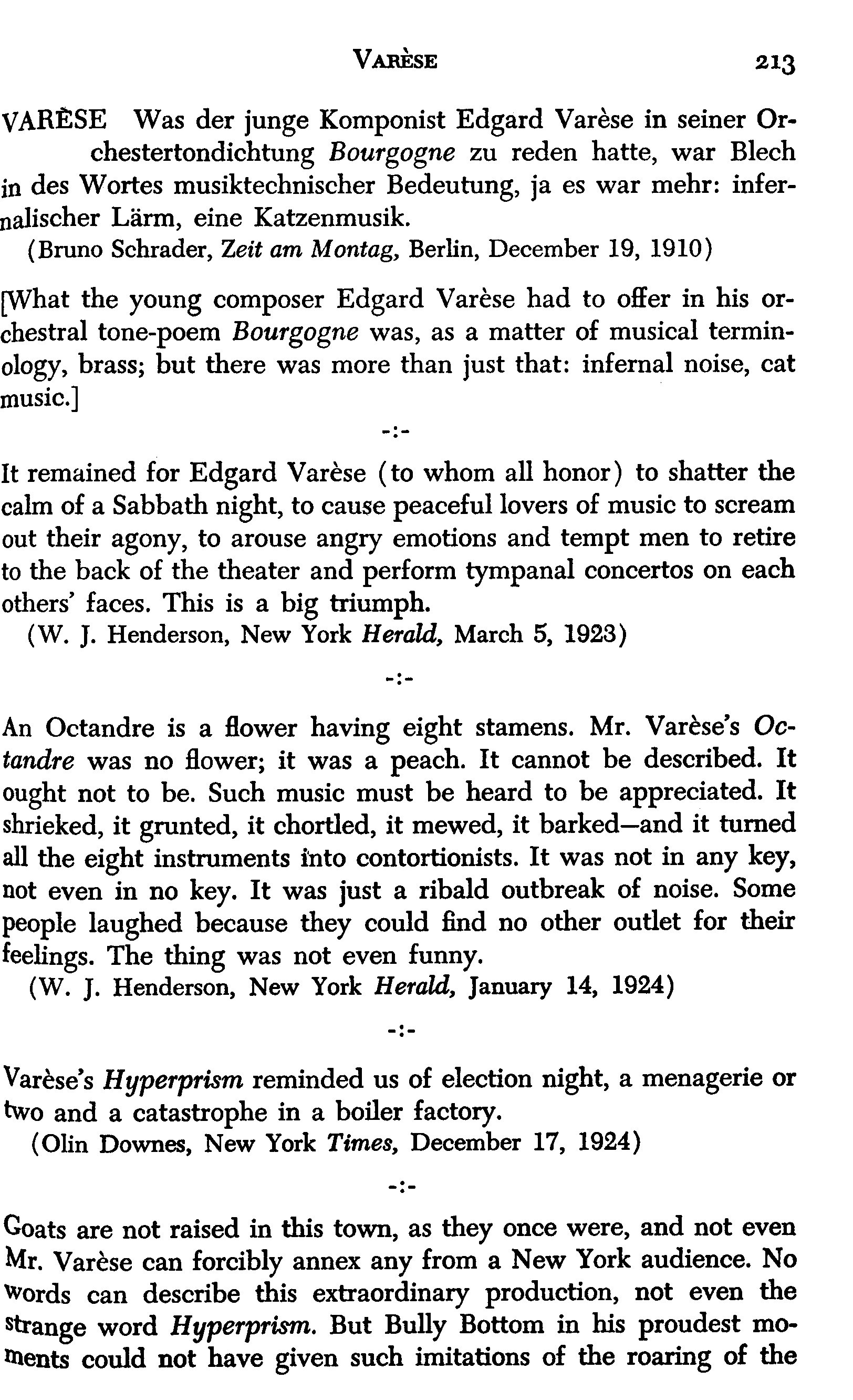
There’s a lovely Nicolas Slonimsky Documentary- A Touch of Genius (56 min)
and an interview with Slonimsky about his friendship with Frank Zappa:
In the last couple of weeks I’ve been working with photos of Home Kitchen meals, from the last decade of trotters in the trough, using Adobe Premiere and posting the results to YouTube. The results so far are available via http://oook.info/HKC/, and sport soundtracks from my duets with Daniel Heïkalo.
I was listening to a recent (July 14 2016) episode of Open Source as I walked yesterday, in which Greil Marcus was interviewed by Max Larkin about three songs (Dylan’s Ballad of Hollis Brown, Geeshie Wiley and LV Thomas’ Last Kind Words Blues, and Bascom Lamar Lunsford’s Wish I Was a Mole in the Ground) that Marcus has written a book around (Three Songs, Three Singers, Three Nations). A short segment seemed especially relevant to issues of art and creativity that I’ve been thinking about lately, so I transcribed it when I got home:
To me, works of art, whether they’re songs, whether they’re novels, whether they’re paintings, whether they’re movies, are fictions: they’re imaginative constructs that people create and then they inhabit and then they tell you stories from that position, as if they’re true. But they’re making things up, they’re lying. These things didn’t happen. And so the fact that Geeshie Wiley and LV Thomas were from here as opposed to there, that they lived at this time as opposed to that time, all of that is interesting and will tell you something about how these songs came to be musically as part of a tradition, but will not tell you anything about why the recordings they made, and especially Motherless Child Blues and Last Kind Words Blues, are absolutely unique, why there is nothing like them. That is because they had the tools and they had the will and the desire and the genius to be able to turn that into an artifact that we can listen to and say “who ARE these people?” and when we say “who are these people, we don’t mean “are they really from Houston?” which is where they were from, was LV Thomas really a lesbian, which she was was. That’s not what we mean by “who are these people?”. It’s like, “what is this ABOUT?” How can people DO these kinds of things? It’s our sense of awe in the face of great art. It’s a sense of coming to grips with our lack of understanding of how something so beautiful, so preordained, so unlikely, has come to be.
click to hear:
The sense of the sublime that inhabits the art that moves us (musical, graphic, narrative, photographic, whatever) is hard to pin down or distill into words. We knows it when we sees it, and that sense of knowing may or may not be transitive: others may not feel or apprehend or catch or get it. I’m aware of this feeling with every batch of photographs I process and put into my Flickr photostream—there’s an ineffable something that inhabits some images, often because of some imaginative construct that I’ve put onto them in capturing or processing. Sometimes there’s a story, either manifest or lurking under the surface. Sometimes it’s just a portent, or an allusion that only comes into focus within a set of images. Here’s one that produced that sort of frisson, though I haven’t yet imagined the narrative into which it might fit:

I have a checkered history of experiments with banjo-family instruments, the most recent episode of which features the current New Instrument, a rare bird indeed: a 1923 5-string plectrum Vega, just arrived from Gryphon in Palo Alto. It’s essentially a tenor banjo, but 5-course instead of 4-course, and with a longer scale (27″) than most tenors, and tuned lower. So perhaps a baritone.
I tripped over it on the Gryphon website, which I visit from time to time, usually about the time that a new issue of Fretboard Journal arrives (and of course I stop by Gryphon whenever I’m in Palo Alto).
Larry Chung plays the very instrument in this YouTube video:
There’s pictorial evidence of former encounters with the family: a brief 5-string flirtation 1973, and the mandobanjo at Deep Gap 1979 (which started my own case of Mando Madness):
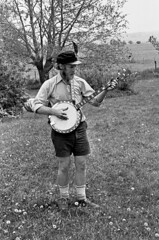

Amanda Petrusich’s Do Not Sell At Any Price: The Wild, Obsessive Hunt for the World’s Rarest 78rpm Records comes as close as anything I’ve read (and I’ve read a lot in this vein) to my own feelings and intuitions about musics, and then extends them into new territory.
With a few notable exceptions, blues music was rowdy and social, and its creators led brash, lustful lives. They drank and roamed and had reckless sex and occasionally stabbed each other in the throat. There was something incongruous about sitting in a dimly lit room, meticulously wiping dust and mold off a blues 78 and noting the serial number in an antique log book. Why not dance or sob or get wasted and kick something over? Some collectors, I knew, did exactly that, but for others, the experience of a rare blues record involved a kind of isolated studiousness, which of course was fine — there’s no wrong way to enjoy music, and I understood that certain contextual or biographical details could help crystallize a bigger, richer picture of a song. But I continued to believe that the pathway that allowed human beings to appreciate and require music probably begins in a more instinctual place (the heart, the stomach, the nether regions). Context was important, but it was never as essential — or as compelling — to me as the way my entire central nervous system involuntarily convulsed
whenever Skip James opened his mouth. (pg 62)
Petrusich interviews a broad array of collectors for their perspectives and personal histories, and has a gimlet-eared instinct for the trenchant quote. Here’s Ian Nagoski on collectors, and more generally on dudes:
It’s dudes hanging out, relating to each other through objects. It’s such a manifestation of dude culture, where guys tend to gather and not talk about their actual lives, if they can avoid it, but instead refer to the engine of their car, or whatever third thing they can talk about. And then through the aesthetics of that, they’ll relate to one another and get a sense of whether somebody is trustworthy or not and if they can actually open up to them. It’s a compensation for all kinds of male skills that are supposed to be present in adolescence that may not be present, so you compensate with other things — the superiority of specialization in some arcane field Science-fiction nerds and baseball-card guys, motorheads. Wanting to talk about your sound system first and your marriage months later. But literally having a shared aesthetic experience of a particular style of speaker could be the foundation of a lifelong, very, very deep male friendship. (pp 184-185)
Anthropologists are prone to connoisseurship of subcultures, appreciating niceties of identity and keeping weather eyes peeled for boundary-defining shibboleths. Lowlifes and marginal folk seem especially attractive, perhaps because they offer exciting alternatives to the bourgeois stolidity of the Buena Gente. In this realm I have more than 30 years of fascination with the Greek underworld of the re[m]betes and the musical genres grouped under the ‘re[m]betika/o’ rubric. Basic source materials include Gail Holst’s Road to Rembetika: Music of a Greek sub-culture songs love, sorrow & hashish (1975) and Elias Petropoulos’ Songs of the Greek Underworld: The Rebetika Tradition (2000).
To assist your exploration if this is unfamiliar territory, there’s a BBC documentary:
Today I came across a really delicious vein of text in Patrick Leigh Fermor’s The Broken Road, replete with the trademarked style for which he is celebrated. He’s describing two dance forms, hasapikos and zembekiko:
They are, in fact, the quintessence of fatalism and morose solitude, a consolation and an anodyne in individual calamity, and with the songs that accompany them create a hard metrical and choreographic counterspell. They have another black mark against them: they are linked with low life in refugee quarters, with drunken cellars and hashish-smoking dens and waterfront bars, with idle hours spent over the nargileh, and with a dandified trick of flicking those tasseled and time-killing amber beads. Traditionally they are accompanied by a sartorial style, now largely obsolete: pointed shoes, peg-top trousers held up by a red sash, the jacket worn loose on the shoulders with sleeves hanging ‚ and by twisted moustaches, a quiff falling over the forehead, and the cap aslant on the back of the head. With this goes a relaxed gait, a languid syncopated flick of the beads round the index finger held in the small of the back, a cigarette in the corner of the mouth, a faintly derisive smile, a poker face, an unflurriable deliberation of gesture and a dangerous ironic light in the veiled eyes. (pp 244-245)
Downright ethnographic, isn’t it? You really should just get the book and read it…